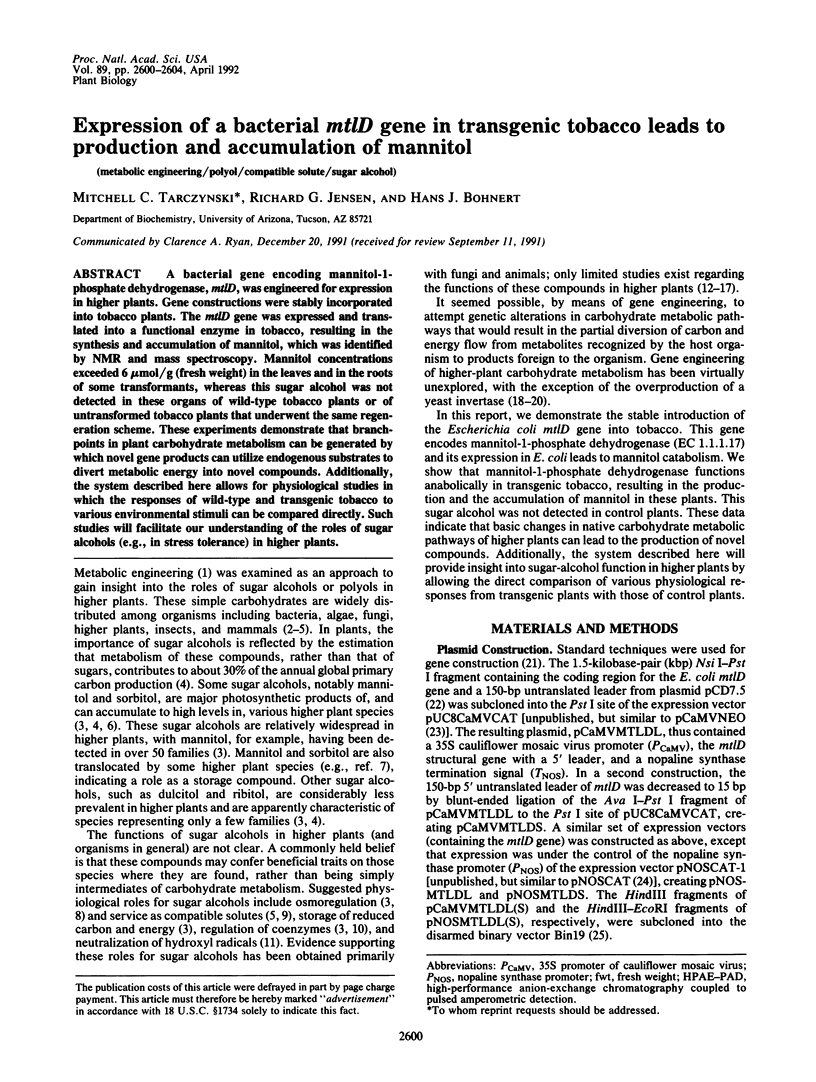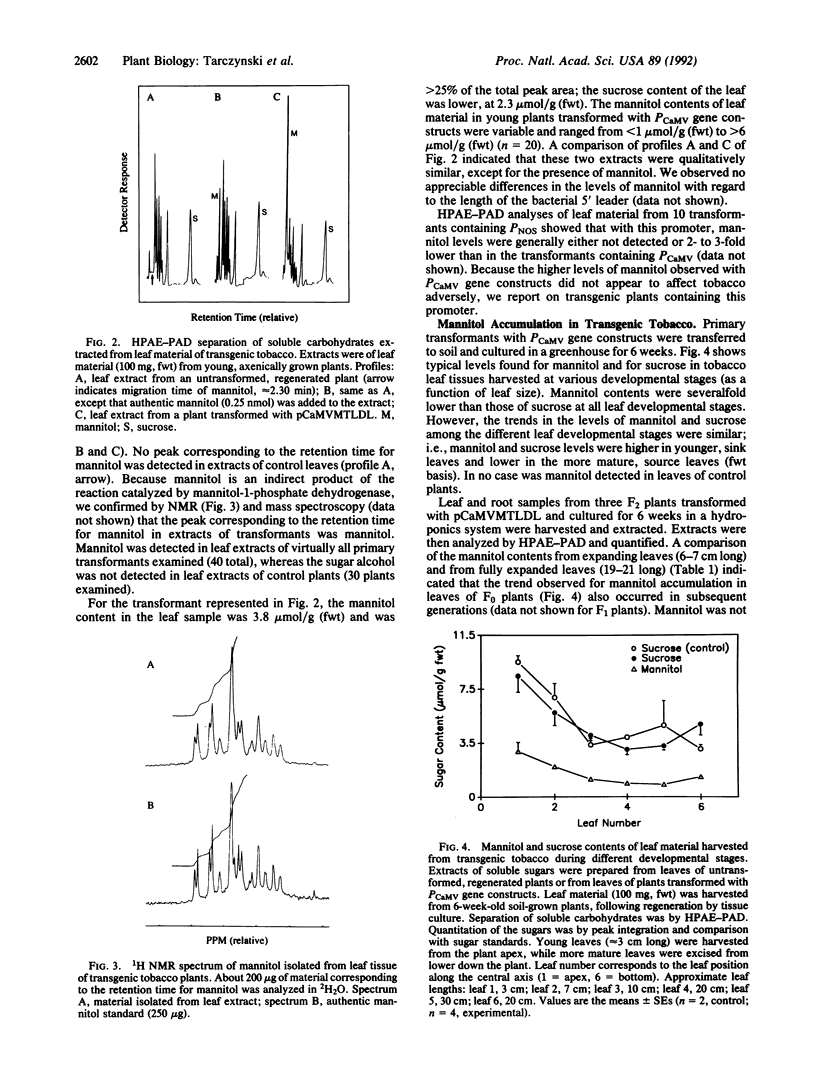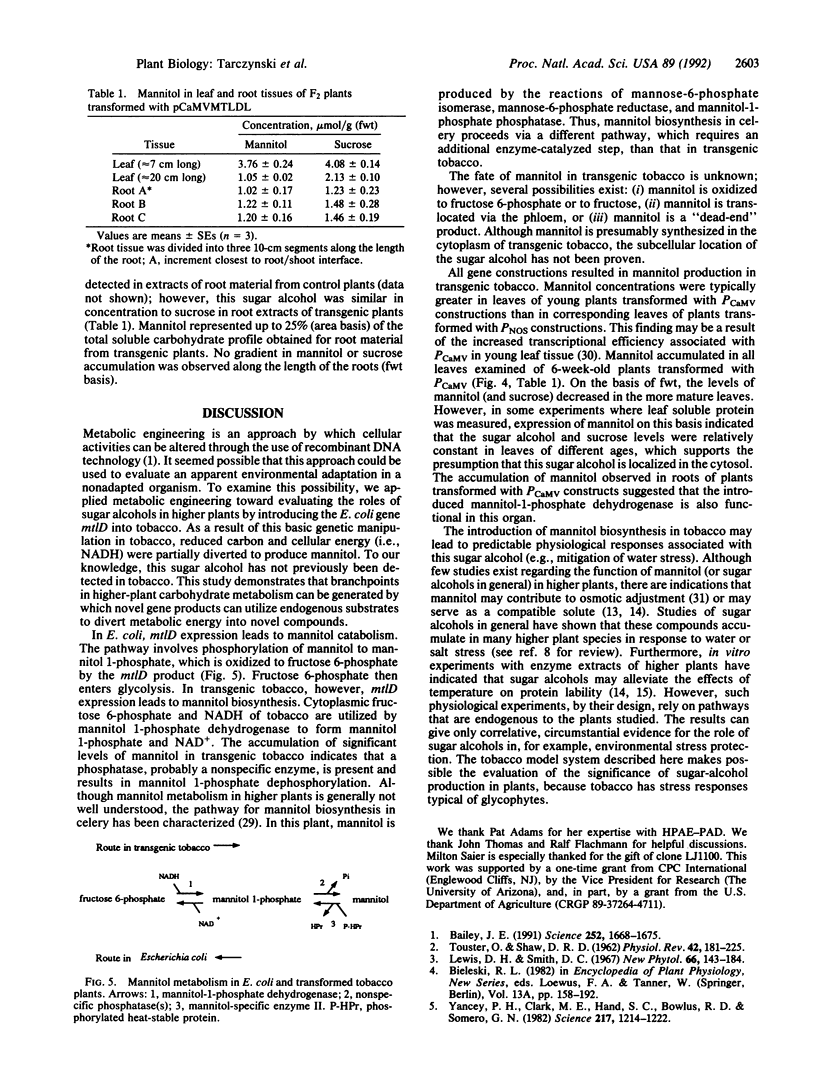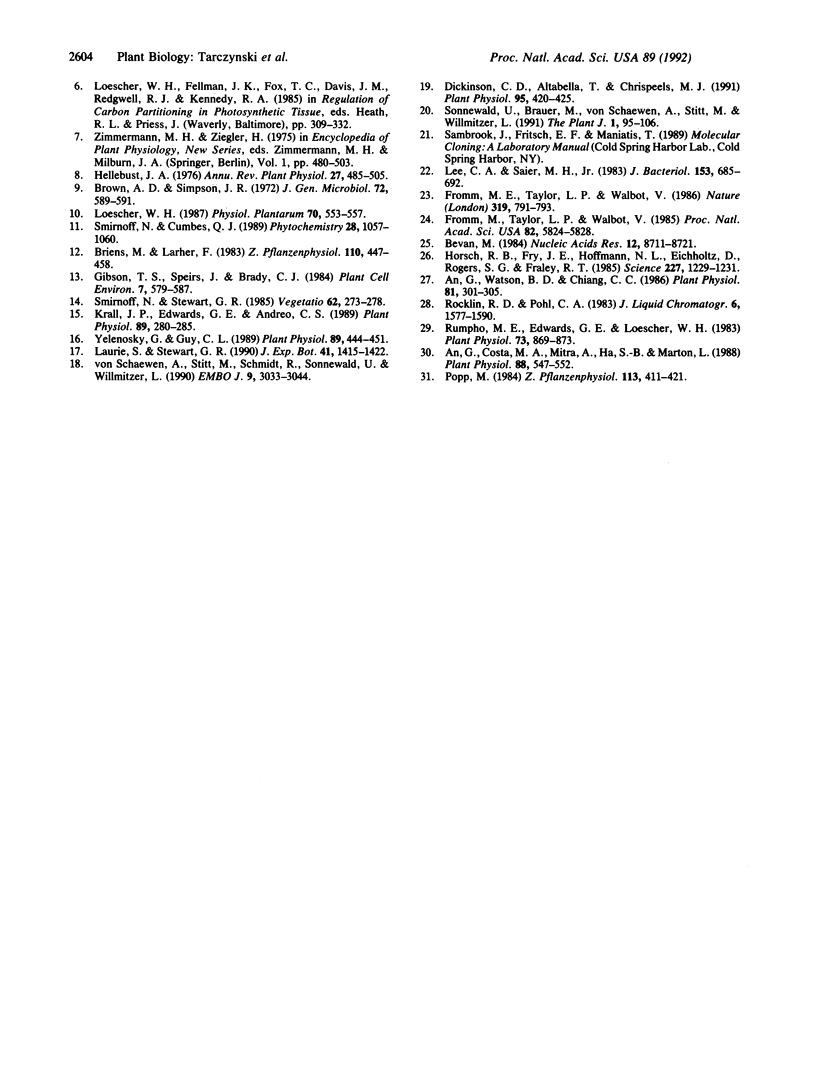Abstract
A bacterial gene encoding mannitol-1-phosphate dehydrogenase, mtlD, was engineered for expression in higher plants. Gene constructions were stably incorporated into tobacco plants. The mtlD gene was expressed and translated into a functional enzyme in tobacco, resulting in the synthesis and accumulation of mannitol, which was identified by NMR and mass spectroscopy. Mannitol concentrations exceeded 6 mumol/g (fresh weight) in the leaves and in the roots of some transformants, whereas this sugar alcohol was not detected in these organs of wild-type tobacco plants or of untransformed tobacco plants that underwent the same regeneration scheme. These experiments demonstrate that branch-points in plant carbohydrate metabolism can be generated by which novel gene products can utilize endogenous substrates to divert metabolic energy into novel compounds. Additionally, the system described here allows for physiological studies in which the responses of wild-type and transgenic tobacco to various environmental stimuli can be compared directly. Such studies will facilitate our understanding of the roles of sugar alcohols (e.g., in stress tolerance) in higher plants.
Full text
PDF




Images in this article
Selected References
These references are in PubMed. This may not be the complete list of references from this article.
- A simple and general method for transferring genes into plants. Science. 1985 Mar 8;227(4691):1229–1231. doi: 10.1126/science.227.4691.1229. [DOI] [PubMed] [Google Scholar]
- An G., Costa M. A., Mitra A., Ha S. B., Márton L. Organ-specific and developmental regulation of the nopaline synthase promoter in transgenic tobacco plants. Plant Physiol. 1988 Nov;88(3):547–552. doi: 10.1104/pp.88.3.547. [DOI] [PMC free article] [PubMed] [Google Scholar]
- An G., Watson B. D., Chiang C. C. Transformation of Tobacco, Tomato, Potato, and Arabidopsis thaliana Using a Binary Ti Vector System. Plant Physiol. 1986 May;81(1):301–305. doi: 10.1104/pp.81.1.301. [DOI] [PMC free article] [PubMed] [Google Scholar]
- Bailey J. E. Toward a science of metabolic engineering. Science. 1991 Jun 21;252(5013):1668–1675. doi: 10.1126/science.2047876. [DOI] [PubMed] [Google Scholar]
- Bevan M. Binary Agrobacterium vectors for plant transformation. Nucleic Acids Res. 1984 Nov 26;12(22):8711–8721. doi: 10.1093/nar/12.22.8711. [DOI] [PMC free article] [PubMed] [Google Scholar]
- Brown A. D., Simpson J. R. Water relations of sugar-tolerant yeasts: the role of intracellular polyols. J Gen Microbiol. 1972 Oct;72(3):589–591. doi: 10.1099/00221287-72-3-589. [DOI] [PubMed] [Google Scholar]
- Dickinson C. D., Altabella T., Chrispeels M. J. Slow-growth phenotype of transgenic tomato expressing apoplastic invertase. Plant Physiol. 1991 Feb;95(2):420–425. doi: 10.1104/pp.95.2.420. [DOI] [PMC free article] [PubMed] [Google Scholar]
- Fromm M. E., Taylor L. P., Walbot V. Stable transformation of maize after gene transfer by electroporation. 1986 Feb 27-Mar 5Nature. 319(6056):791–793. doi: 10.1038/319791a0. [DOI] [PubMed] [Google Scholar]
- Fromm M., Taylor L. P., Walbot V. Expression of genes transferred into monocot and dicot plant cells by electroporation. Proc Natl Acad Sci U S A. 1985 Sep;82(17):5824–5828. doi: 10.1073/pnas.82.17.5824. [DOI] [PMC free article] [PubMed] [Google Scholar]
- Krall J. P., Edwards G. E., Andreo C. S. Protection of Pyruvate,Pi Dikinase from Maize against Cold Lability by Compatible Solutes. Plant Physiol. 1989 Jan;89(1):280–285. doi: 10.1104/pp.89.1.280. [DOI] [PMC free article] [PubMed] [Google Scholar]
- Lee C. A., Saier M. H., Jr Use of cloned mtl genes of Escherichia coli to introduce mtl deletion mutations into the chromosome. J Bacteriol. 1983 Feb;153(2):685–692. doi: 10.1128/jb.153.2.685-692.1983. [DOI] [PMC free article] [PubMed] [Google Scholar]
- Rumpho M. E., Edwards G. E., Loescher W. H. A pathway for photosynthetic carbon flow to mannitol in celery leaves : activity and localization of key enzymes. Plant Physiol. 1983 Dec;73(4):869–873. doi: 10.1104/pp.73.4.869. [DOI] [PMC free article] [PubMed] [Google Scholar]
- Sonnewald U., Brauer M., von Schaewen A., Stitt M., Willmitzer L. Transgenic tobacco plants expressing yeast-derived invertase in either the cytosol, vacuole or apoplast: a powerful tool for studying sucrose metabolism and sink/source interactions. Plant J. 1991 Jul;1(1):95–106. doi: 10.1111/j.1365-313x.1991.00095.x. [DOI] [PubMed] [Google Scholar]
- TOUSTER O., SHAW D. R. Biochemistry of the acyclic polyols. Physiol Rev. 1962 Apr;42:181–225. doi: 10.1152/physrev.1962.42.2.181. [DOI] [PubMed] [Google Scholar]
- Yancey P. H., Clark M. E., Hand S. C., Bowlus R. D., Somero G. N. Living with water stress: evolution of osmolyte systems. Science. 1982 Sep 24;217(4566):1214–1222. doi: 10.1126/science.7112124. [DOI] [PubMed] [Google Scholar]
- Yelenosky G., Guy C. L. Freezing tolerance of citrus, spinach, and petunia leaf tissue : osmotic adjustment and sensitivity to freeze induced cellular dehydration. Plant Physiol. 1989 Feb;89(2):444–451. doi: 10.1104/pp.89.2.444. [DOI] [PMC free article] [PubMed] [Google Scholar]
- von Schaewen A., Stitt M., Schmidt R., Sonnewald U., Willmitzer L. Expression of a yeast-derived invertase in the cell wall of tobacco and Arabidopsis plants leads to accumulation of carbohydrate and inhibition of photosynthesis and strongly influences growth and phenotype of transgenic tobacco plants. EMBO J. 1990 Oct;9(10):3033–3044. doi: 10.1002/j.1460-2075.1990.tb07499.x. [DOI] [PMC free article] [PubMed] [Google Scholar]



